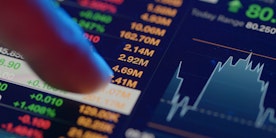Dividend ETFs vs Stocks – Which Is a Better Investment in 2025?
All products and services featured are independently selected by WikiJob. When you register or purchase through links on this page, we may earn a commission.
Whether you are new to investing or looking to build a portfolio, there are many different financial instruments that you could look at buying.
Stocks and dividend ETFs are just two of these, and they are often given as a choice – but knowing which is right for you can be complicated.
Dividend ETFs and stocks have many similarities, but they do have some differences – and the main difference is that a stock represents an investment in a single company, whereas an ETF is a bundle of assets. Both have pros and cons, but ultimately the right one for you to invest in will depend on your personal circumstances and preferences.
In this article, you will learn the definition of stocks and Dividend ETFs, and then look at the benefits and drawbacks of both – ETF vs dividend stocks – before comparing them directly to try and demonstrate what type of investor each would suit.
Remember that, as with all investment, there are risks to your capital whether you choose to buy stocks or get involved in a Dividend ETF, so bear this in mind when you are making your decision.
What Is a Stock?
Before making any decisions, it’s helpful to know the difference between a dividend ETF vs dividend stocks.
Stocks are issued by companies to help them raise funds, and ownership of a stock represents ownership of a fraction of the issuing company’s assets and profits.
Stocks are sometimes referred to as assets, and units of stock are known as shares. Owning shares in a company does not mean that you own the corporation, but it does mean that you are able to receive dividends if they are issued, are able to vote in shareholder meetings, and can sell your shares to someone else if you want to.
Popular stocks to invest in come from corporations like Apple and Microsoft. Stocks are traded on the stock exchange, and the price can fluctuate according to the movement of the market and other factors.
What Are Dividend ETFs?
An Exchange-Traded Fund (ETF) is a pooled investment, which is essentially a basket of securities that trade like a single stock. An ETF can track an index, a sector, or a specific commodity.
One ETF can contain stocks of dozens of companies, and investors typically choose them when they want to diversify their holdings. ETFs are managed much like a mutual fund, but they are traded on the stock exchange like single stocks, which makes them more liquid.
ETFs can also pay dividends in the same way as some stocks. Some examples of ETFs that are popular include the S&P 500, which tracks the performance of the S&P 500 index, and there are ETFs that track specific sectors like biotechnology and even Bitcoin, as well as finance and retail.
Dividend ETF vs Stocks: Similarities and Differences
Stocks/Dividend Investing vs ETF: Similarities
Both types of investment can be traded on the stock exchange, which makes them easier to access than some other investment types. You can use your usual broker to access both stocks and dividend ETFs.
The whole point of an investment is to reach a state of Alpha – which is where your investment portfolio outperforms the market, and you are making a profit.
With both stocks and dividend ETFs, there are two ways you can make money. Long-term investment can yield a profit as the value of the stock or ETF increases, and you can also get some passive income from dividend payments, which usually happen quarterly.
The availability of stocks and ETFs are similar, too. As mentioned, they can both be purchased (and sold) on the stock exchange, which means that there should be limited problems with liquidity in both cases.
A slightly more sobering similarity is that both stocks and dividend ETFs do come with an element of risk to your capital – so any purchases should be carefully considered before jumping in.
Differences Between an Individual Stock vs Dividend ETFs
The first main difference is diversification. If you buy a stock, you are investing in one specific company. If you buy an ETF, however, you are getting a range of different stocks and other financial instruments, which means you have a more diverse portfolio immediately, even if they are all in the same sector.
While both stocks and ETFs offer similar opportunities for passive income from dividends, ETFs tend to be more consistent with dividend payments if they are offered. Stock dividends are subject to reduction or even removal by the corporation, especially if they are having cash flow problems.
Similarly, long-term profit can differ between the two. Higher rewards can come from choosing the right stock to buy at the right time – and getting that sweet spot. This can sometimes be much more lucrative even than an ETF containing the same stock, as the price is diluted because of the other assets in the bundle.
The level of interaction that you will need during the process differs between stocks and dividend ETFs. Even passive ETFs are managed in some way, and you do not need to control anything other than your investment amount.
When it comes to stocks, you will need to research the companies that you want to invest in and be ready to buy and sell depending on the actions of the market and different indicators and charts.
The cost of purchase is another difference. Some stocks are available to purchase without commission, and ETFs tend to come with management costs built in. It would probably work out much more expensive to buy the individual stocks that you could get in an ETF.
Finally, risk. It’s already been mentioned that both stocks and dividend ETFs come with risk. However, simply because with buying a stock you are putting your eggs in one basket, there is more risk involved – your capital and profit hinges on the performance of that company.
With an ETF, the risk is mitigated by being spread out over several different companies – with the aim that if one price starts falling, the rest will keep you in the black.

Dividend ETF vs Stocks: The Pros and Cons
The Benefits of Stocks
There are several benefits that come from choosing to invest in stocks.
Stocks usually offer a higher return potential, as you will become a shareholder with all the perks that offers, from dividend payments to long-term growth.
Stocks that offer dividends usually have a strong track record of performance and payouts, which makes them feel like a safer bet in the long term.
Another benefit of choosing to invest in a stock for the cost-savvy investor is that many platforms and brokers offer commission-free trading options, which means you will not need to calculate the broker’s cut on top of your purchase.
This can allow you to buy more stocks from the same corporation, or even branch out and buy something different to create your own diversity with the cash you could save.
The Downside of Stocks
Choosing the right stocks to invest in is something that takes both effort and time – not to mention a solid understanding of things like research, charting, and indicators.
There are some stocks that are more likely to be chosen because they have performed well and steadily for many years, especially in the financial and technological sectors, but for those who are looking to make the most profit, it is the undervalued stocks that are likely to explode in value that are the golden choice.
Aside from the effort, you will need to consider the risk. Even the ‘safest’ stocks can plunge in value when things change – like interest rates rising, problems with suppliers and manufacturers, or global sociopolitical issues.
This can have a devastating impact on your profit and even on your whole investment.
The Benefits of Dividend ETFs
Choosing an ETF offers immediate diversification to your portfolio with minimal effort. Whether you choose a fund that tracks an index, a commodity, or a sector, the basket of assets that you are buying will potentially include dozens of high-performing stocks and bonds.
This diversification is also key to minimizing or at least mitigating your risk. As mentioned, if one company in your portfolio is having a bad run, then there is more of a chance that the performance of other businesses will bolster the fund and keep you in profit.
The Downside of Dividend ETFs
While the hands-off investor might choose an ETF for ease, the lack of control on what you are investing in can be a consideration for more savvy investors. Funds that are built based on the performance of an index, for example, might not change their chosen corporation regularly enough to keep up with market trends.
When it comes to cost, the management fees charged by the fund manager can sometimes reduce your profit margin more than you might be comfortable with.
Usually, a passive fund has less cost in comparison to a managed fund – but both could be prohibitively costly for you.
Dividend ETF vs Stocks: Which to Choose?
Situations Where Stocks Might Be a Better Choice
-
If you are an investor who wants to be involved in your portfolio and make all the decisions about what to invest in and when to sell.
-
You might be an income-seeker who has time to research or maybe has sources for information about the undervalued stocks that might be worth choosing for the future.
-
If you are a long-term investor who is looking for profit at the end, stocks might be the best choice, but you need to be savvy about the potential for risk – and the potential for rewards.
-
You might consider choosing individual stocks in sectors like retail and finance. Retail is one of the best places to look if you want to get in early on a new business or a well-known brand that is seeing a surge in popularity. The finance industry is usually a good choice (although this can be risky with rising interest rates and other things).
Situations Where Dividend ETFs Might Be a Better Choice
Dividend ETFs are great for those looking for regular passive income thanks to the quarterly distributions that are usually made. This is in addition to the long-term value of the ETF, don’t forget.
You might choose an ETF if you are more risk-averse and prefer to have a done-for-you diversification without extra effort – or the need to extensively research individual company histories and financial performance.
ETFs are also a good choice for investors who want to be hands-off with their portfolios, preferring to pay the management fee for the fund to be managed on your behalf. Passive investment doesn’t have to mean a lack of profit, but don’t forget that this investment is a long-term strategy.
You might consider an ETF that tracks the performance of the top tech companies, or one that looks specifically at the companies in top indices that offer the biggest and steadiest distributions.
Frequently Asked Questions
For a passive, inexperienced investor looking for diversification, a dividend ETF might be the best option.
Whereas savvy investors – or someone who is willing to do the research that will help them buy the right stock – can take advantage of the potentially higher rewards of individual stocks.
Dividend ETFs are a good idea if you want to invest in a multitude of stocks and other assets, diversifying your portfolio and mitigating your exposure to risk. They offer both regular dividend distributions as well as long-term value, without much need for market knowledge.
The main problem that investors have with dividend ETFs is that this passive investment option can have costly management expenses – and no option to choose which stocks are included in the fund as it progresses.
Whether a dividend ETF is better for you as an investor than individual stocks depends entirely on your own circumstances, including things like your risk appetite, how much you know about investing, and how much research and other work you want to do with your investment.
The highest dividend ETF changes relatively regularly, depending on market performance, but at the moment, iShares Currency Hedged MSCI Eurozone ETF is offering a dividend yield of 19.35%, which is considerably higher than many other funds.
A dividend trap is when a corporation has to suspend dividend payments to shareholders, usually because of a financial crisis, and then is expected to make distributions when they have returned to generating profit – but the company needs to pay back their accumulated accounting losses.
In the UK, there is a dividend allowance of £2,000 a year that does not attract taxation. Above this amount, you will be expected to pay income tax based on the taxpayer rate bracket that you fall under.
Final Thoughts
When looking at dividend investing vs ETFs, the more you know about the similarities and differences between these financial instruments, the easier it will be to decide which is best for you.
Stocks are great for savvy investors who want to be more hands-on with their investments, while dividend ETFs are a good choice for passive investors who want their investment portfolio diversified for them.
Remember that any investment comes with risk, and you should never invest more than you can afford to lose.
WikiJob does not provide tax, investment or financial services and advice. The information is being presented without consideration of the investment objectives, risk tolerance or financial circumstances of any specific investor and might not be suitable for all investors. Past performance is not indicative of future results. Investing involves risk including the possible loss of principal.





